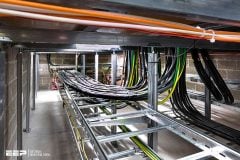A lightning discharge develops in three stages: first, the collisions between ice particles and water droplets together with gravity separate positive and negative charges inside the thunder cloud and buildup a voltage. Then a discharge grows, forming a so-called streamer-leader tree.
Finally, when a conducting path is created between cloud and ground, the cloud discharges through the so-called return stroke; currents then reach tens or hundreds of kA, and the released Ohmic heat brings the channel temperatures up to 28000 K.
Under normal circumstances, air is a quite poor conductor because free electrons rapidly attach to oxygen molecules. However, in a suffciently strong electric field (higher than 3.2 MV/m in air at standard temperature and pressure) a free electron can gain enough energy to liberate a second electron when it impacts ona molecule, and an ionization avalanche sets in.
However, in most electrical discharges, including lightning, the background electric field is almost everywhere one to three orders of magnitude below the breakdown value.











Hi
My doubt is wheather thunder bolt from cloud to ground discharge occurs right, it strikes in ground different points “Can we make it to strike on required point or area on ground”????